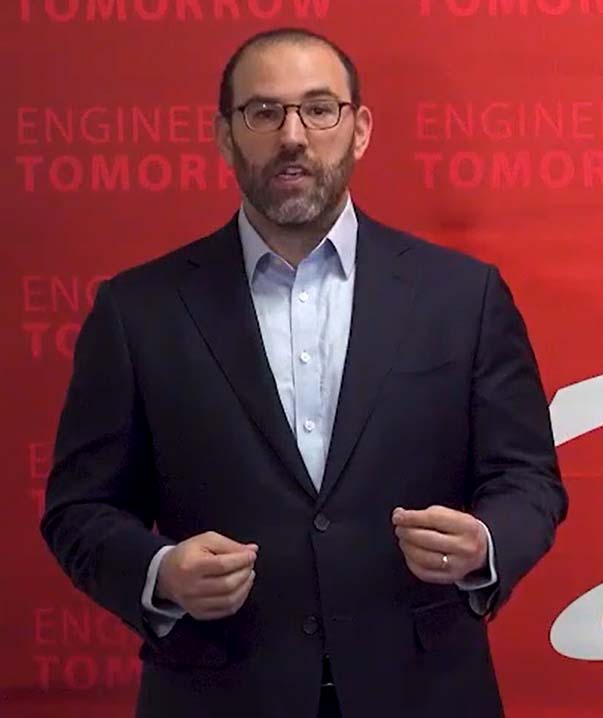In a virtual press conference, Danfoss discussed several of its new technologies, as well as the challenges and opportunities the HVACR industry faces this year.
John Galyen, North America president at Danfoss, started the conference by noting that 2021 was a challenging year for most companies — including Danfoss — due to the COVID pandemic, supply chain and logistics issues, labor shortages, and a sharp rise in customer demand in the second quarter that was not expected.
“I have to say I'm very proud of our employees, because our production colleagues showed up every day to build the products that our customers need,” he said. “And to the many of my fellow colleagues who kept service levels high when working from home, this has not been easy, but we have performed well. At the same time, we acquired Eaton’s hydraulics business in a $3 billion cash transaction, which is a big deal for Danfoss. It strengthens our position in the Power Solutions segment globally, but also locally here in North America, where we'll add approximately $1 billion in sales and an additional 3,000 colleagues in the region.”
Regarding expectations for 2022, Galyen said that Danfoss expects strong growth to continue through the first half of the year and then begin to normalize as the lingering supply chain and logistics issues start to ease. “We are forecasting double digit organic growth after adjusting for inflation, as most of our businesses are well positioned to support the trends in the market.”
Those trends include decarbonization and electrification, which Danfoss is able to support through the use of available, proven, and under-deployed technologies that will have a significant impact in the short-term, said Galyen. “Energy efficiency needs to be our first fuel. It's something that we can do now. Every kilowatt saved today means a better tomorrow.”
Danfoss is well-positioned to help customers lead the way in energy-efficient HVACR systems, said Galyen, noting the new technologies Danfoss has developed: heat exchangers, dedicated outdoor air systems (DOAS), more efficient heat pumps, and compressors compatible with low-GWP and ultra-low GWP refrigerants. With the coming phasedown in HFC refrigerants, “Danfoss not only has the technologies, but also the knowledge and expertise to help our customers navigate this transition,” said Galyen.
Regulatory Landscape
John Sheff, director of public and industry affairs at Danfoss, then shared insights about the evolving regulatory landscape, including the AIM Act, which went into effect earlier this year.

REFRIGERANT TRANSITION: In the policy and regulatory update, John Sheff discussed the AIM Act and how it cleared the way for a smooth transition to the next generation of refrigerants.
“[The AIM Act] cleared the way for a smooth transition not only to the next generation of refrigerants, but to new technologies and increased efficiency as well,” he said. “That path however, is still not as smooth as it could be, and obstacles still exist.”
One of those obstacles is that fewer than 10 states have either updated their building codes or passed legislation to allow the use of mildly flammable (A2L) refrigerants, which are likely going to take the place of R-410A in air conditioning equipment as soon as January 1, 2025.
“The model building codes, the uniform mechanical code, and the International Code Council likely won't be updated to incorporate ASHRAE 15.2 and UL 60335-2-40 and 2-89 until sometime in 2024,” said Sheff. “This means that by the time January 1, 2025 arrives, it is very unlikely that all 50 states will have updated their building code to allow for A2L refrigerants.”
In response to that likelihood, EPA is planning for uneven rollouts of sector-based controls depending on how many states are ready to adopt A2Ls, he said. But on top of that, the AIM Act's first large decrease in available supply of HFC refrigerant is set to occur on January 1, 2024.
“This 40% drop in supply combined with some percentage of states whose building codes do not allow for A2Ls means a potential shortfall in available HFC refrigerant,” said Sheff. “This same scenario played itself out around the European Union's F-gas regulations in 2017. Consequently, HFC prices spiked nearly 1,000% in a matter of months and did not ease until the building codes were updated.”
The U.S. market is well aware of this potential shortfall several years in advance, noted Sheff, and AHRI is working diligently with states to update building codes to allow for A2L refrigerants. “And most importantly, the industry as a whole is stepping up its efforts to maximize and reclaim HFC refrigerant. I'm hopeful that these efforts, when combined, will be enough to avoid the worst impacts of an HFC shortfall in 2024.”
Sankar Padhmanabhan, global applications expert in air conditioning at Danfoss, then talked about DOAS and how they play a vital role in improving IAQ and ventilation with improved efficiency by applying variable-speed compressors. Hans Ole Matthiesen, head of global refrigeration segment marketing at Danfoss, discussed the company’s heat recovery technologies and the importance of heat reuse and recovery in reducing carbon emissions and showed demonstration cases in data centers, supermarkets and ice rinks.
The briefing also featured a recent Danfoss customer — Jae Chon, business development manager at Chesapeake Systems — who discussed their installation of a new HVAC system with a synchronized hydronic loop at the Towson, Maryland courthouse using Danfoss components.



Report Abusive Comment